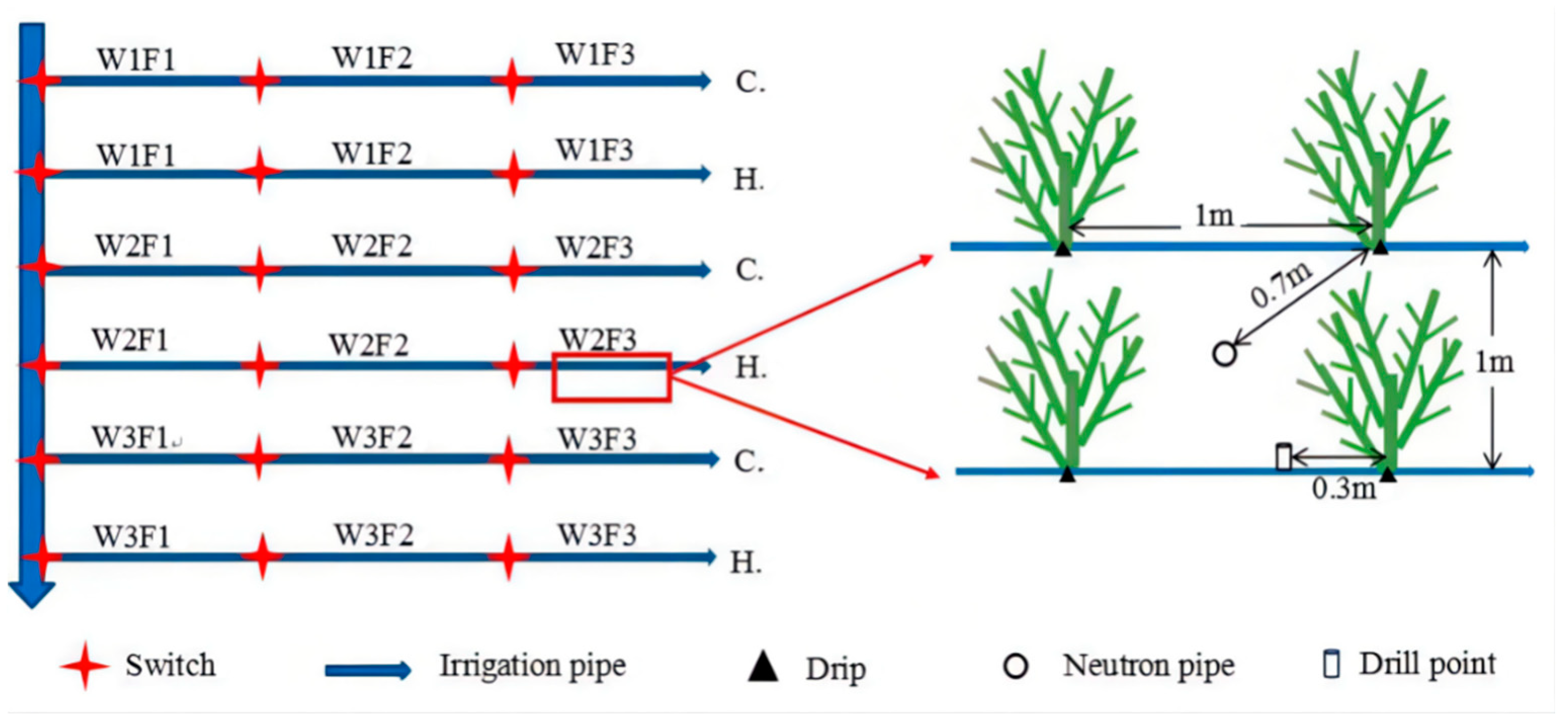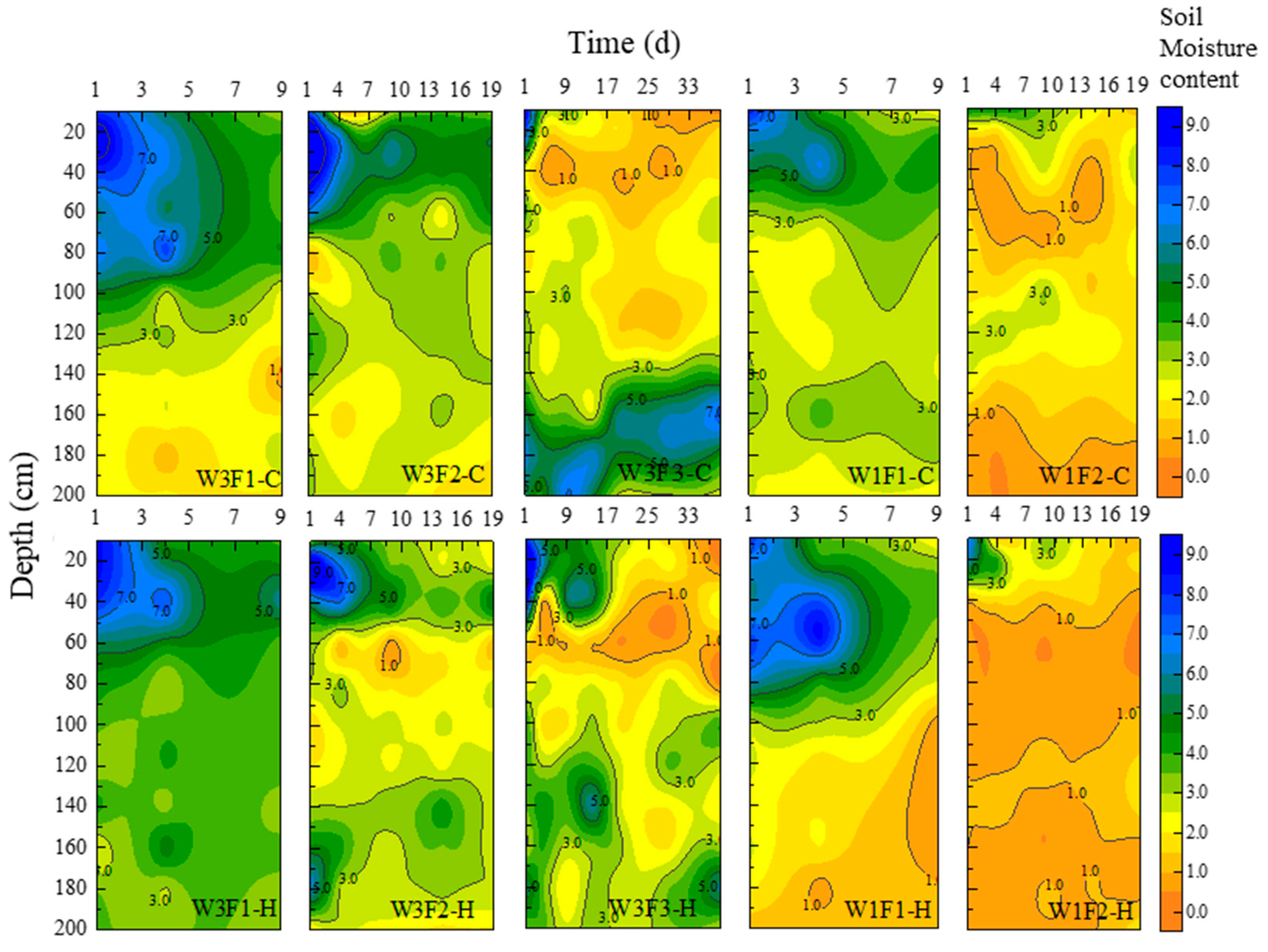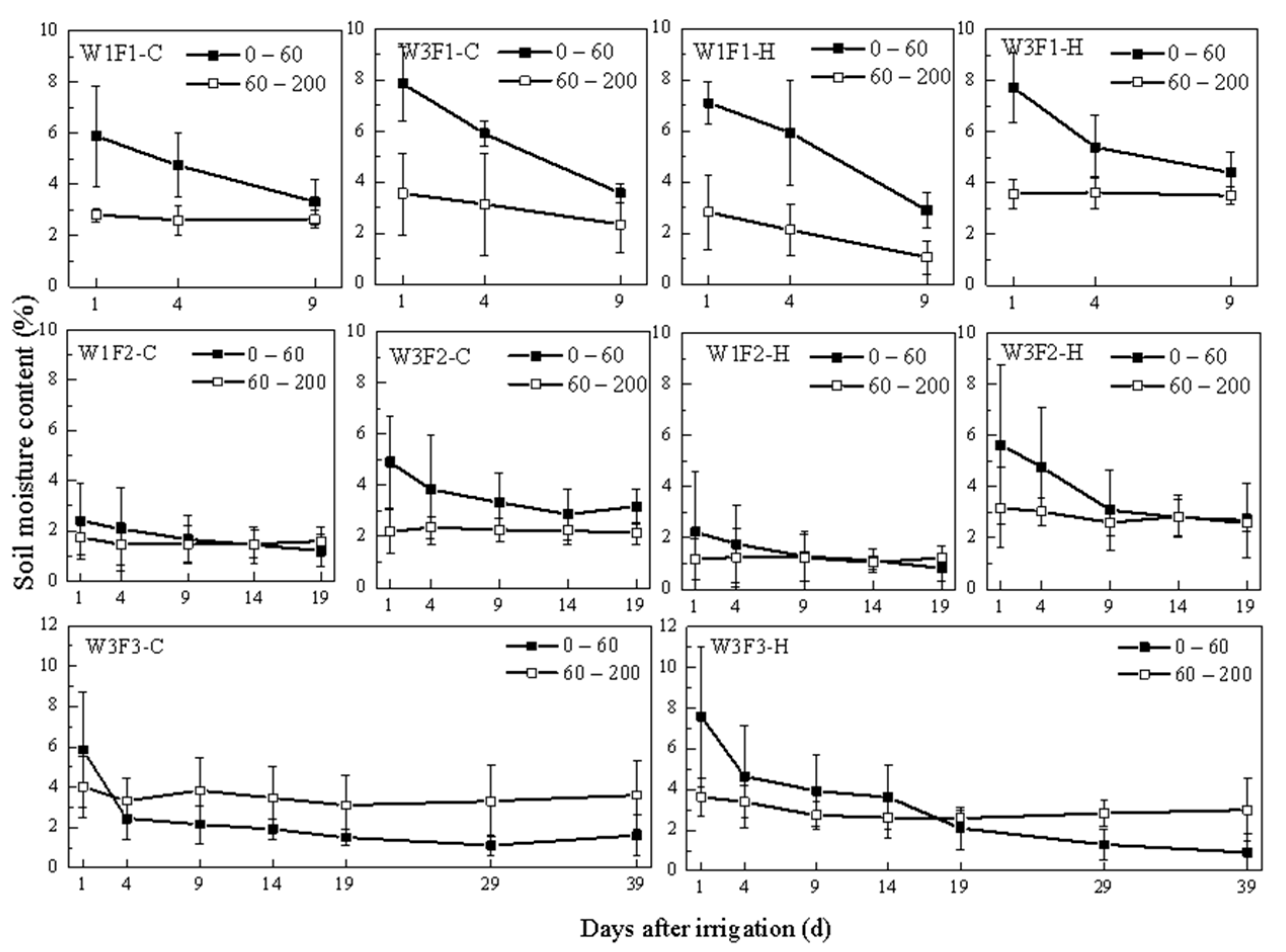Effects of Irrigation Regimes on Soil Water Dynamics of Two Typical Woody Halophyte Species in Taklimakan Desert Highway Shelterbelt
Abstract
1. Introduction
2. Materials and Methods
2.1. Study Area
2.2. Experiment Design and Data Processing
3. Results
3.1. Effect of Irrigation Period on the Spatial Distribution of Soil Water Content
3.2. Temporal Variation in Soil Moisture Profile during Irrigation Period under Different Irrigation Regimes
3.3. Response of Soil Moisture to Irrigation Regime in Different Months
4. Discussion
5. Conclusions
- (1)
- Their soil water content at 100–200 cm is significantly greater under the irrigation regime with a 17.5 mm irrigation amount than that under a 35 mm irrigation amount. Increasing the amount of water for single irrigation and prolonging the irrigation period will lead to more effective irrigation water use. After irrigation, the change in soil moisture of the two species in the shallow 0–60 cm layer can be divided into a rapid decline period (1–9 d), a slow decline period (9–19 d), and a relatively stable period (19–39 d). The decrease rate of soil moisture at 0–60 cm depth is significantly higher than that at 60–200 cm depth. The soil moisture below 200 cm replenishes the soil moisture below 60 to 200 cm.
- (2)
- From May to July, the plant growth is vigorous and the temperature gradually increases, and the soil water is in the net consumption stage. The plant growth rate slows down from July to September, and the temperature decreases. The soil water is in the net replenishment stage; the difference in soil water content between 0 and 300 cm is the largest in July and August and the smallest in September.
- (3)
- The irrigation regime combining a 35 mm irrigation amount with 10 days benefits soil water storage and water content with respect to Calligonum, while the irrigation regime combining a 35 mm irrigation amount with 40 days is best for Haloxylon.
Author Contributions
Funding
Data Availability Statement
Conflicts of Interest
References
- Li, C.; Lei, J.; Zhao, Y.; Xu, X.; Li, S. Effect of saline water irrigation on soil development and plant growth in the Taklimakan Desert Highway shelterbelt. Soil Tillage Res. 2015, 146, 99–107. [Google Scholar] [CrossRef]
- Zhang, J.G.; Lei, J.Q.; Wang, Y.D.; Zhao, Y.; Xu, X.W. Survival and growth of three afforestation species under high saline drip irrigation in the Taklimakan Desert, China. Ecosphere 2016, 7, e01285. [Google Scholar] [CrossRef]
- Zhang, B.; Kang, S.; Li, F.; Zhang, L. Comparison of three evapotranspiration models to Bowen ratio-energy balance method for a vineyard in an arid desert region of northwest China. Agric. For. Meteorol. 2008, 148, 1629–1640. [Google Scholar] [CrossRef]
- Dai, S.Y.; Lei, J.Q.; Zhao, J.F.; Fan, J.; Fan, D.; Zeng, F.; Ye, K. The characteristics of groundwater and their effects on eco-environment of desert-oasis transitional zone in western Qira of China. J. Arid. Land Resour. Environ. 2009, 23, 4782–4786. [Google Scholar]
- Chartzoulakis, K.S. Salinity and olive: Growth, salt tolerance, photosynthesis and yield. Agric. Water Manag. 2005, 78, 108–121. [Google Scholar] [CrossRef]
- Chen, M.; Kang, Y.; Wan, S.; Liu, S. Drip irrigation with saline water for oleic sunflower (Helianthus annuus L.). Agr. Water Manage. 2009, 96, 1766–1772. [Google Scholar] [CrossRef]
- Feikema, P.M.; Morris, J.D.; Connell, L.D. The water balance and water sources of a Eucalyptus plantation over shallow saline groundwater. Plant Soil 2010, 332, 429–449. [Google Scholar] [CrossRef]
- Xu, X.; Li, B.; Wang, X. Progress in study on irrigation practice with saline groundwater on sandlands of Taklimakan Desert hinterland. Chinese Sci. Bull. 2006, 51, 161–166. [Google Scholar] [CrossRef]
- Tedeschi, A.; Dell’Aquila, R. Effects of irrigation with saline waters, at different concentrations, on soil physical and chemical characteristics. Agric. Water Manag. 2005, 77, 308–322. [Google Scholar] [CrossRef]
- Huang, C.H.; Xue, X.; Wang, T.; De Mascellis, R.; Mele, G.; You, Q.G.; Peng, F.; Tedeschi, A. Effects of saline water irrigation on soil properties in northwest China. Environ. Earth Sci. 2010, 63, 701–708. [Google Scholar] [CrossRef]
- Zhang, J.; Xu, X.; Lei, J.; Sun, S.; Fan, J.; Li, S.; Gu, F.; Qiu, Y.; Xu, B. The salt accumulation at the shifting aeolian sandy soil surface with high salinity groundwater drip irrigation in the hinterland of the Taklimakan Desert. Sci. Bull. 2008, 53, 63–70. [Google Scholar] [CrossRef][Green Version]
- Wang, X.; Xu, X.; Lei, J.; Li, S.; Wang, Y. The vertical distribution of the root system of the desert highway shelterbelt in the hinterland of the Taklimakan Desert. Sci. Bull. 2008, 53, 79–83. [Google Scholar] [CrossRef][Green Version]
- Li, S.; Lei, J.; Xu, X.; Wang, H.; Fan, J.; Gu, F.; Qiu, Y.; Xu, B.; Gong, Q.; Zheng, W. Topographical changes of ground surface affected by the shelterbelt along the Tarim Desert Highway. Sci. Bull. 2008, 53, 8–21. [Google Scholar] [CrossRef]
- Li, C.; Shi, X.; Mohamad, O.A.; Gao, J.; Xu, X.; Xie, Y. Moderate irrigation intervals facilitate establishment of two desert shrubs in the Taklimakan Desert Highway Shelterbelt in China. PLoS ONE 2017, 12, e0180875. [Google Scholar] [CrossRef] [PubMed]
- Ding, X.; Zhou, Z.; Xu, X.; Wang, Y. Dynamics of Soil Water and Salt in Soil under Artificial Plantation Shelterbelt Drip-irrigated with Saline Water in the Center of the Taklimakan Desert. Acta Pedol. Sin. 2016, 53, 103–116. [Google Scholar]
- Fu, S.; Hu, S.; Hao, L.; Wang, Z. Water sources of dominant plants in haloxylon ammodendron community at the southern edge of gurbantunggut desert. J. Desert Res. 2018, 38, 1024–1032. [Google Scholar]
- Zhang, Y.M.; Pan, H.X.; Pan, B.R. Distribution Characteristics of Biological Crust on Sand Dune Surface in Gurbantunggut Desert, Xinjiang. J. Soil Water Conserv. 2004, 18, 61–64. [Google Scholar]
- Beltrán, J.M. Irrigation with saline water: Benefits and environmental impact. Agric. Water Manag. 1999, 40, 183–194. [Google Scholar] [CrossRef]
- Verma, A.; Gupta, S.; Isaac, R. Use of saline water for irrigation in monsoon climate and deep water table regions: Simulation modeling with SWAP. Agric. Water Manag. 2012, 115, 186–193. [Google Scholar] [CrossRef]
- Han, W.; Cao, L.; Yimit, H.; Xu, X.; Zhang, J. Optimization of the saline groundwater irrigation system along the Tarim Desert Highway Ecological Shelterbelt Project in China. Ecol. Eng. 2012, 40, 108–112. [Google Scholar] [CrossRef]
- Guo, Z. Estimating Method of Maximum Infiltration Depth and Soil Water Supply. Sci. Rep. 2020, 10, 9726. [Google Scholar] [CrossRef] [PubMed]
- Jiang, X.J.; Liu, W.; Chen, C.; Liu, J.; Yuan, Z.-Q.; Jin, B.; Yu, X. Effects of three morphometric features of roots on soil water flow behavior in three sites in China. Geoderma 2018, 320, 161–171. [Google Scholar] [CrossRef]
- Ma, X.D.; Chen, Y.N.; Zhu, C.G.; Li, W.H. The variation in soil moisture and the appropriate groundwater table for desert riparian forest along the Lower Tarim River. J. Geogr. Sci. 2011, 21, 150–162. [Google Scholar] [CrossRef]
- Duan, Z.H. Study on Soil Water Cycle Under Irrigation in Takelamagan Desert. J. Arid. Land Resour. Environ. 2001, 15, 63–67. [Google Scholar]
- Resco, V.; Ignace, D.D.; Sun, W.; Huxman, T.E.; Williams, J.F.W.G. Chlorophyll fluorescence, predawn water potential and photosynthesis in precipitation pulse-driven ecosystems: Implic. Ecol. Studies. Funct. Ecol. 2008, 22, 479–483. [Google Scholar] [CrossRef]







| Processing Number | Single Irrigation Volume (mm) | Irrigation Period (d) | Total Irrigation Volume at 40 Days (mm) |
|---|---|---|---|
| W3F1 | 35 | 10 | 140 |
| W3F2 | 35 | 20 | 70 |
| W3F3 | 35 | 40 | 35 |
| W1F1 | 17.5 | 10 | 70 |
| W1F2 | 17.5 | 20 | 35 |
| Treatment | Soil Water Content % | |||||
|---|---|---|---|---|---|---|
| 0–100 cm | 100–200 cm | 0–200 cm | ||||
| Average Value | Standard Deviation | Average Value | Standard Deviation | Average Value | Standard Deviation | |
| W3F1-C | 5.73 a | 1.08 | 2.93 a | 1.29 | 4.33 a | 1.84 |
| W3F2-C | 2.72 b | 1.10 | 1.15 b | 0.46 | 1.93 b | 1.15 |
| W3F3-C | 3.37 b | 1.26 | 1.70 b | 0.45 | 2.53 b | 1.26 |
| W1F1-C | 3.92 b | 1.41 | 1.93 b | 1.01 | 2.93 b | 1.58 |
| W1F2-C | 2.95 b | 2.45 | 1.57 b | 0.81 | 2.26 b | 1.95 |
| W3F1-H | 3.97 ab | 1.03 | 4.90 a | 0.70 | 4.44 a | 0.99 |
| W3F2-H | 2.69 bc | 0.91 | 3.43 b | 1.17 | 3.06 b | 1.11 |
| W3F3-H | 4.43 a | 1.42 | 2.43 c | 0.34 | 3.43 b | 1.44 |
| W1F1-H | 3.09 ab | 1.32 | 0.86 d | 0.71 | 1.97 c | 1.54 |
| W1F2-H | 1.76 c | 1.01 | 1.20 d | 0.59 | 1.48 c | 0.87 |
| Treatment | Difference in Soil Water Storage in September and May (mm) | |||
|---|---|---|---|---|
| 0–100 cm | 100–200 cm | 200–300 cm | 0–300 cm | |
| W1F1-C | 51.00 | −8.03 | −6.62 | 36.35 |
| W1F2-C | 26.71 | −3.88 | −3.75 | 19.08 |
| W1F3-C | 34.13 | −2.22 | −5.70 | 26.21 |
| W2F1-C | 7.47 | −10.02 | −9.44 | −11.99 |
| W2F2-C | 26.59 | −4.44 | −13.93 | 8.22 |
| W2F3-C | −10.95 | −3.58 | −8.28 | −22.81 |
| W3F1-C | 34.62 | −2.94 | 4.70 | 36.37 |
| W3F2-C | 4.72 | −6.12 | 1.80 | 0.40 |
| W3F3-C | 31.66 | 2.62 | −0.45 | 33.83 |
| W1F1-H | −15.54 | 0.12 | 6.70 | −8.72 |
| W1F2-H | −13.64 | 23.99 | 21.04 | 31.40 |
| W1F3-H | −5.12 | −16.35 | −2.72 | −24.19 |
| W2F1-H | 32.22 | −11.46 | −2.56 | 18.20 |
| W2F2-H | −8.66 | 10.34 | −1.18 | 0.50 |
| W2F3-H | 36.16 | −8.07 | 5.96 | 34.05 |
| W3F1-H | 14.64 | −12.45 | 8.41 | 10.60 |
| W3F2-H | 4.10 | −8.50 | 7.00 | 2.60 |
| W3F3-H | 15.81 | 17.32 | 17.68 | 50.81 |
Publisher’s Note: MDPI stays neutral with regard to jurisdictional claims in published maps and institutional affiliations. |
© 2022 by the authors. Licensee MDPI, Basel, Switzerland. This article is an open access article distributed under the terms and conditions of the Creative Commons Attribution (CC BY) license (https://creativecommons.org/licenses/by/4.0/).
Share and Cite
Liu, J.; Zhao, Y.; Zhang, J.; Hu, Q.; Xue, J. Effects of Irrigation Regimes on Soil Water Dynamics of Two Typical Woody Halophyte Species in Taklimakan Desert Highway Shelterbelt. Water 2022, 14, 1908. https://doi.org/10.3390/w14121908
Liu J, Zhao Y, Zhang J, Hu Q, Xue J. Effects of Irrigation Regimes on Soil Water Dynamics of Two Typical Woody Halophyte Species in Taklimakan Desert Highway Shelterbelt. Water. 2022; 14(12):1908. https://doi.org/10.3390/w14121908
Chicago/Turabian StyleLiu, Jiao, Ying Zhao, Jianguo Zhang, Qiuli Hu, and Jie Xue. 2022. "Effects of Irrigation Regimes on Soil Water Dynamics of Two Typical Woody Halophyte Species in Taklimakan Desert Highway Shelterbelt" Water 14, no. 12: 1908. https://doi.org/10.3390/w14121908
APA StyleLiu, J., Zhao, Y., Zhang, J., Hu, Q., & Xue, J. (2022). Effects of Irrigation Regimes on Soil Water Dynamics of Two Typical Woody Halophyte Species in Taklimakan Desert Highway Shelterbelt. Water, 14(12), 1908. https://doi.org/10.3390/w14121908









